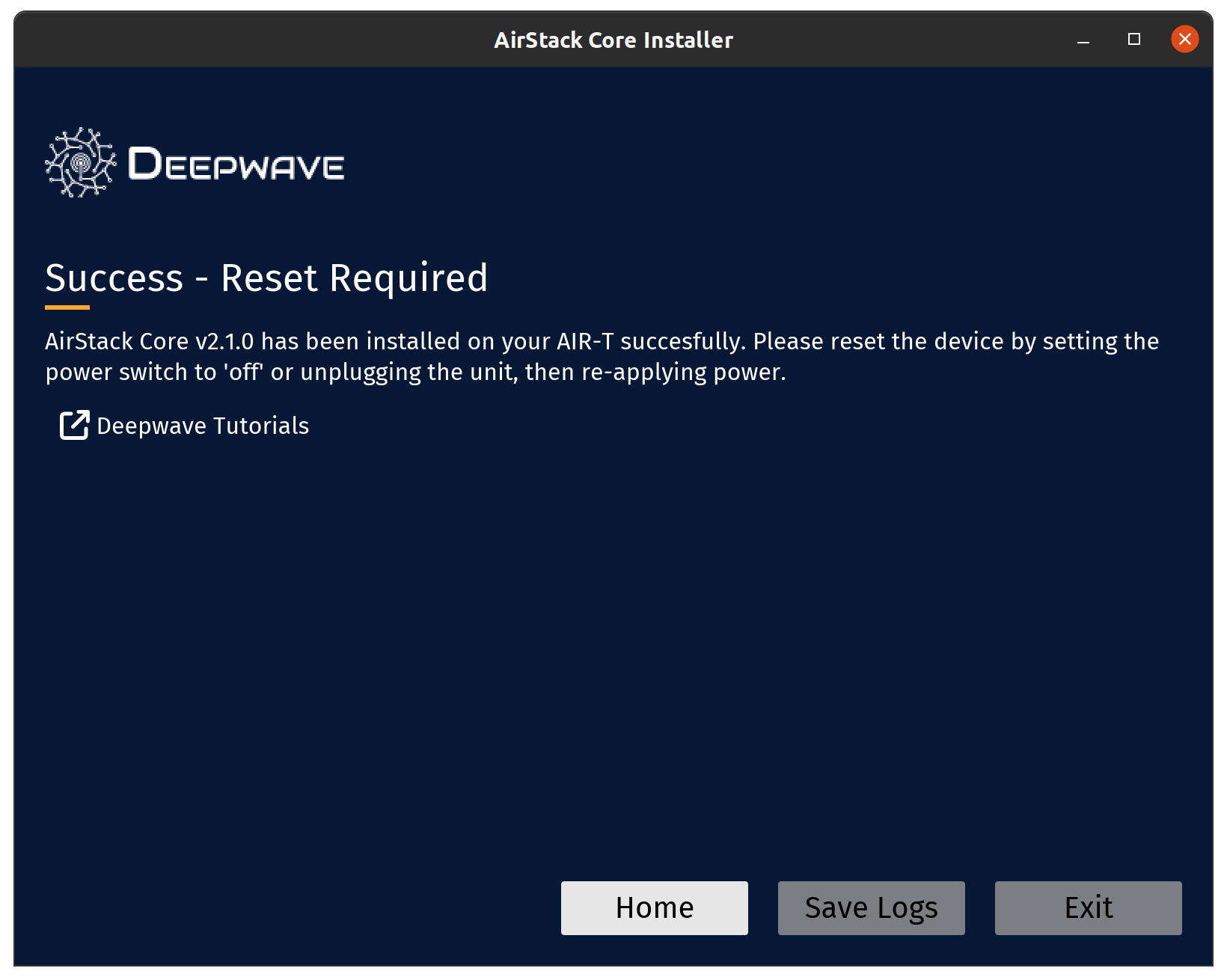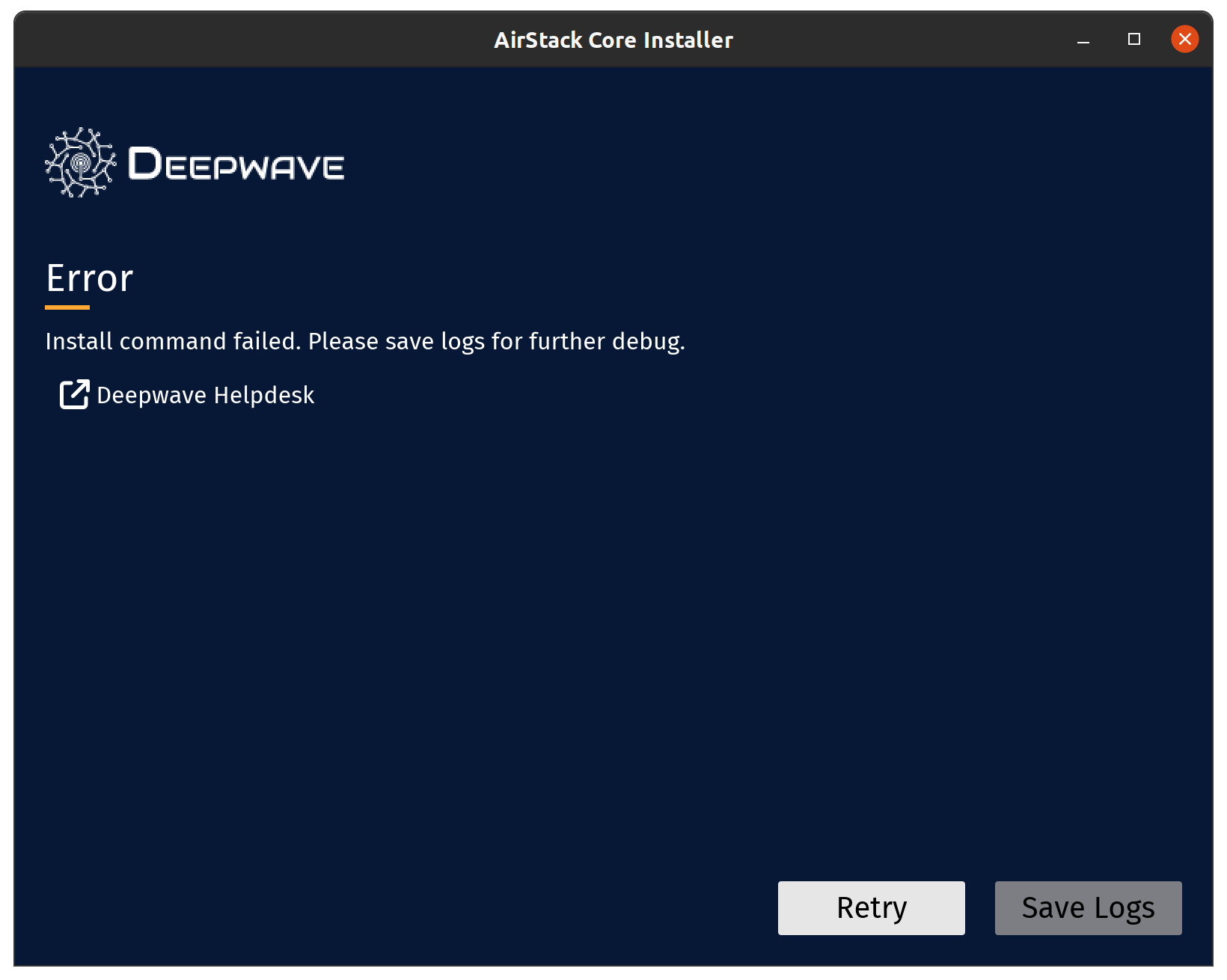AirStack Core Installation¶
This documentation is written for the latest version of AirStack (v2.1+). For flashing older versions of AirStack (v1.x and earlier), please see these instructions.
This procedure is used to install the AirStack Core software suite on to an AIR-T. This software contains both the underlying operating system for the Jetson module as well as drivers and board support for the hardware interfaces present on the AIR-T. Installing AirStack Core will restore your AIR-T's software to factory settings and delete all user data.
NOTE : If you are having issues flashing your device, check out our FAQ: AirStack Installation FAQ.
Prerequisites¶
To flash the AIR-T you will need:
- An x86 host machine running Linux
- This procedure was tested using Ubuntu 24.04 LTS, although Ubuntu 18.04 and later will work, as will many other Linux distributions.
- An AIR-T
- Keyboard, mouse, and monitor plugged into the AIR-T
- Micro USB cable
- AirStack software downloaded from the Developer Portal at www.deepwave.ai
Important Compatibility Note¶
Using the AirStack flashing utilities requires that Python 3 is available on your system. If python is not available on your host computer, the install will not complete.
AirStack Installation Procedure¶
NOTE: FLASHING THE AIR-T WILL ERASE EVERYTHING ON THE OPERATING SYSTEM. MAKE SURE THAT YOU HAVE A BACKUP OF ANYTHING YOU NEED PRIOR TO PERFORMING THIS PROCEDURE
As of Airstack 2.1+ Deepwave provides an install tool to simplify updating your devices. Follow these steps to run the AirStack Core Installer software:
1. Make sure that you have a proper backup of any personal code or files from the AIR-T.
2. Connect the MGMT port from the AIR-T to the Linux host computer.
3. Boot the AIR-T into recovery mode. See the section below for instructions.
4. Go to the directory in which AirStack was downloaded and extract the contents of the package. For example, if the software was downloaded to your Downloads folder, enter the following commands in a command shell:
cd ~/Downloads
tar -xzvf airstack-core-<VERSION>.tgz
cd airstack-core-<VERSION>
<VERSION> is replaced with the version you downloaded. 5. Start the AirStack Core Installer Tool:
You will need to accept the AirStack Core license and press 'start'.

6. Click through to accept the warning and the installation will begin. This process can take up to 30 minutes.


7. Once the installation is complete you will see the success message below. You will now need to reset your device by switching the power to off or removing the power source from the device.

8. Once the AIR-T boots, you will be prompted to create a user on the AIR-T. Follow the on-screen instructions and the AIR-T will reboot once this step has completed.
Installation Issues¶
If there is a problem installing AirStack Core software on your AIR-T you will see an error message similar to the one below. If you are unable to move past the error on your own, please hit the 'save logs' button and submit a Deepwave helpdesk ticket with the logs attached.

Placing the AIR-T Into Recovery Mode¶
To place the AIR-T into recovery mode, follow this procedure. Note that you must be in a fresh recovery mode to flash the AIR-T (before each time the flash command is executed, the system must be power cycled into recovery mode).
Using Software¶
When the micro-USB is connected from the AIR-T to the host computer, and the AIR-T is not in recovery mode, the USB cable will function as a network connection with the IP addresses displayed in the table below. In this configuration, the AIR-T may be logged in to via ssh from the Linux host. When the AIR-T is in recovery mode, this IP interface does not exist.
| System | IP Address |
|---|---|
| Linux host | 192.168.55.100 |
| AIR-T | 192.168.55.1 |
When logged in to the AIR-T, enter the following command in a terminal window on the AIR-T:
$ reboot --force forced-recovery
Administrative permissions are required to execute the command, so a normal user will need to run with sudo. The board will immediately reboot and come up in recovery mode.
On the host, verify that the device is in recovery mode and communicating with your computer. See this section for details: Verification of Recovery Mode
Using Hardware Buttons¶
An AIR-T can be placed into recovery mode by using a reset button on the board itself. This allows you to recover the unit even if the operating system has been completely wiped.
-
Locate the reset (
RST) button on the AIR-T front panel -
Connect the AIR-T to the host computer using the micro USB cable.
-
Press and hold the
RSTbutton for 8 seconds.The status light on the radio will flash when you have held it long enough. -
On the host connected to the AIR-T via USB, verify that the device is in recovery mode and communicating with your computer using the procedure in the Verification of Recovery Mode section below.
Verification of Recovery Mode¶
To verify that your device is in recovery mode, you will use the output of the lsusb command from the host computer when the AIR-T is connected via the micro-usb and powered on. Here is an example for the AIR7310:
$ lsusb
Bus 003 Device 013: ID 0955:7323 NVidia Corp.
On the host computer, open a terminal and type lsusb, which should show a device with a description of "NVidia Corp." When looking at the hexadecimal numbers that are returned, the format is VENDOR_ID:PRODUCT_ID. You can determine the mode of the micro-usb interface (Recover or Network Mode) based on the PRODUCT_ID. If you are in recovery mode, you will see the PRODUCT_ID equal to the value in column 2 of the table below for your AIR-T model.
| AIR-T Model | PRODUCT_ID (Recovery Mode) | PRODUCT_ID (Network Mode) |
|---|---|---|
| AIR7310 | 0955:7323 | 0955:7020 |
